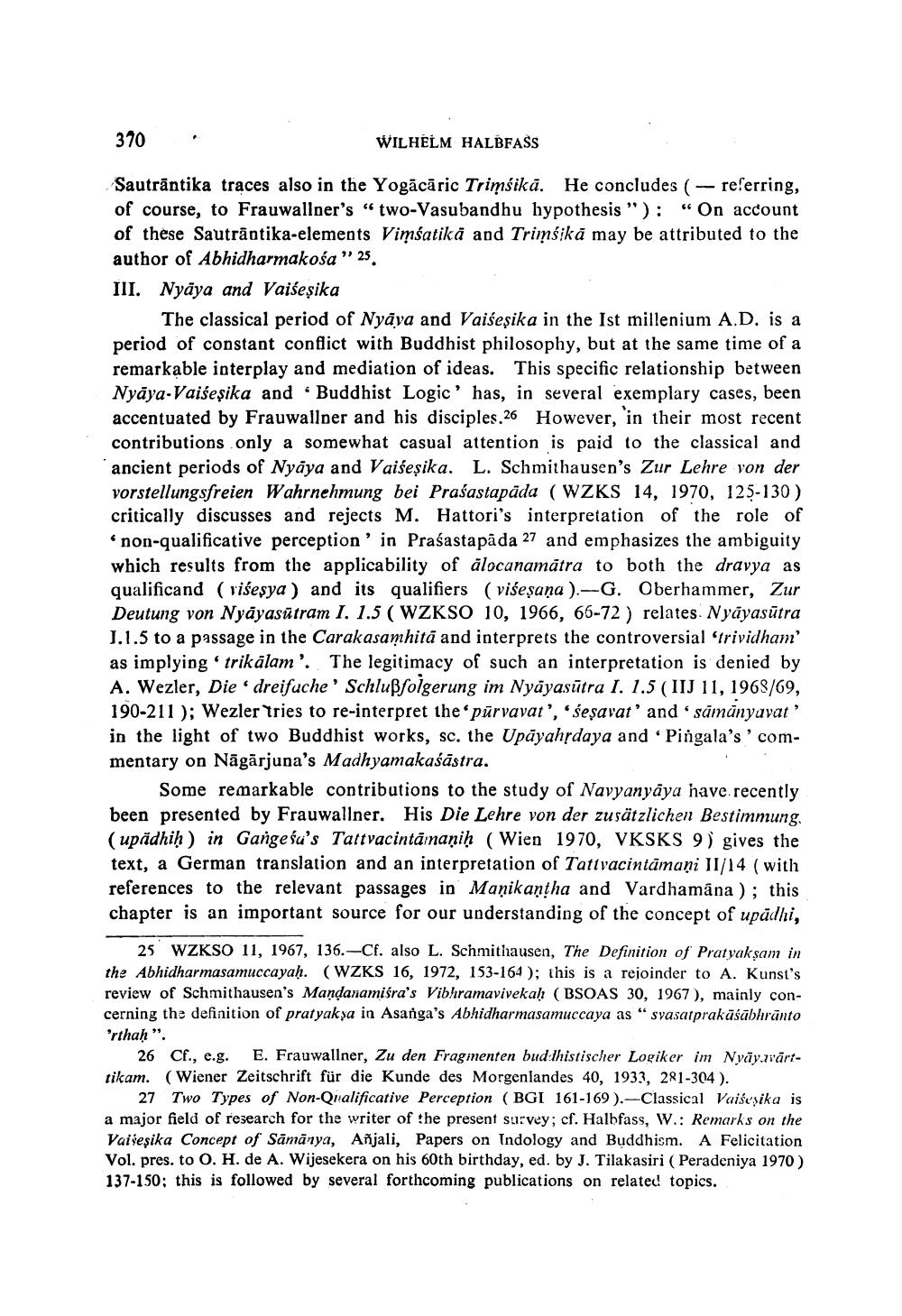________________
370
.
WILHELM HALBFASS
Sautrāntika traces also in the Yogācāric Trimśikā. He concludes ( -- relerring, of course, to Frauwallner's "two-Vasubandhu hypothesis"): “On account of these Sautrāotika-elements Vimsatikā and Trimsikā may be attributed to the author of Abhidharmakośa" 25. III. Nyāya and Vaiseșika
The classical period of Nyāya and Vaiseșika in the Ist millenium A.D. is a period of constant conflict with Buddhist philosophy, but at the same time of a remarkable interplay and mediation of ideas. This specific relationship between Nyāya-Vaiseșika and · Buddhist Logic' has, in several exemplary cases, been accentuated by Frauwallper and his disciples.26 However, in their most recent contributions only a somewhat casual attention is paid to the classical and ancient periods of Nyāya and Vaiseșika. L. Schmithausen's Zur Lehre von der vorstellungsfreien Wahrnehmung bei Prasastapāda (WZKS 14, 1970, 125-130 ) critically discusses and rejects M. Hattori's interpretation of the role of
non-qualificative perception' in Prasastapāda 27 and emphasizes the ambiguity which results from the applicability of alocanamātra to both the dravya as qualificand (riseşya ) and its qualifiers (viśeşaņa).-G. Oberhammer, Zur Deutung von Nyāyasūtram 1. 1.5 (WZKSO 10, 1966, 66-72) relates Nyāyasūtra 1.1.5 to a passage in the Carakasamhita and interprets the controversial 'Trividham' as implying trikālam'. The legitimacy of such an interpretation is denied by A. Wezler, Die dreifache Schlußfolgerung im Nyāyasūtra 1. 1.5 (IIJ 11, 1968/69, 190-211 ); Wezler tries to re-interpret the pūrvavat', 'seşavat' and 'sámányavat' in the light of two Buddhist works, sc. the Upāyahrdaya and Pingala's 'commentary on Nāgārjuna's Madhyamakaśāstra.
Some remarkable contributions to the study of Navyanyāya have recently been presented by Frauwallner. His Die Lehre von der zusätzlichen Bestimmung. (upädhiḥ) in Gangesa's Tattvacintamaṇiḥ (Wien 1970, VKSKS 9) gives the text, a German translation and an interpretation of Tattvacintāmaņi II/14 ( with references to the relevant passages in Manikantha and Vardhamana ); this chapter is an important source for our understanding of the concept of upādhi,
25 WZKSO 11, 1967, 136.-Cf. also L. Schmithausen, The Definition of Pratyakşam in the Abhidharmasamuccayaḥ. (WZKS 16, 1972, 153-164); this is a rejoinder to A. Kunst's review of Schmithausen's Mandanamiśra's Vibhiramavivekah (BSOAS 30, 1967), mainly concerning the definition of pratyakṣa in Asanga's Abhidharmasamuccaya as" svasatprakāśābhrānto 'rthaḥ".
26 Cf., e.g. E. Frauwallner, Zu den Fragmenten bud Thistischer Logiker im Nyāy.zvārttikam. (Wiener Zeitschrift für die Kunde des Morgenlandes 40, 1933, 281-304).
27 Two Types of Non-Qualificative Perception (BGI 161-169).--Classical Vaiseșika is a major field of research for the writer of the present survey; cf. Halbfass, W.: Remarks on the Vaiseșika Concept of Sāmānya, Añjali, Papers on Indology and Buddhism. A Felicitation Vol. pres. to O. H. de A. Wijesekera on his 60th birthday, ed. by J. Tilakasiri (Peradeniya 1970) 137-150; this is followed by several forthcoming publications on related topics.




